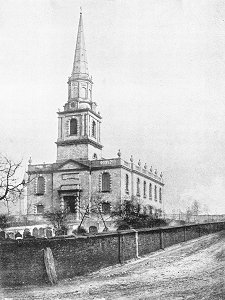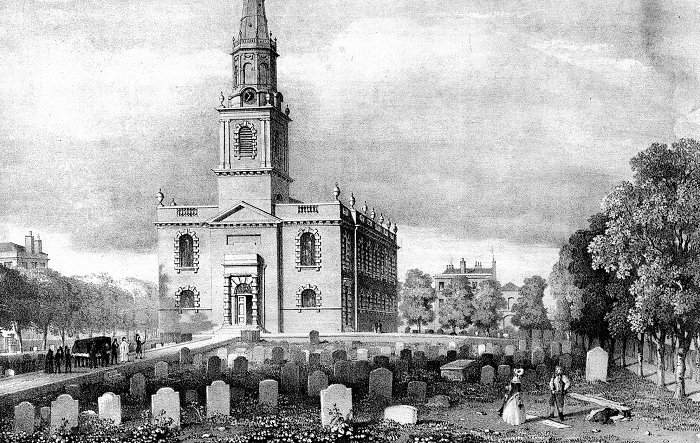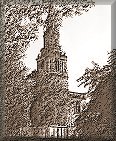The New Church Isaac Taylor's plan of Wolverhampton (1750-1) shows the town to consist of 1440 dwellings. These housed 7454 inhabitants in streets clustered around the ancient parish church of St. Peter. Increasing prosperity brought about by the rise of manufacturing industry led to a rapid rate of growth of the town. Similar conditions were experienced to the east of Wolverhampton as the exploitation of the discovery of a rich coalfield with limestone and iron ore gave rise to what was shortly to become 'The Black Country'. St. Peter's Church, with its vast Wolverhampton parish, was a Collegiate Church and a Royal Peculiar from 1479 to 1846, independent of the Bishop of Lichfield. The Dean of Windsor, who was also the Dean of Wolverhampton, held the living. Since 1700 there had been a growing recognition of the need for more church accommodation in the town, both for worship and burial. Dr. Pennystone Boothe, one of the few Deans to actually live in Wolverhampton, had been instrumental in the building of three chapels of ease. These were Wednesfield (1746), Willenhall (1748), and Bilston (1753). The latter two were rebuilt on the sites of previous churches. The site for a proposed fourth church on the southern margin of the town had been selected some time previously and a voluntary subscription opened to raise money for that project. Funds accumulated very slowly until, in 1750, the trustees decided to seek the support of an aristocratic patron and approached the Earl of Stamford and Warrington. The 4th Earl, Lord Harry Grey (1715-1768), had vast estates at Dunham Massey, Bradgate and Enville. He agreed to become perpetual Patron and made a gift of £1000 to the building fund. He applied to this gift the condition that he and his successors should have the right of presentation to the living of the New Church. A private Act of Parliament was obtained which received the Royal Assent in 1755. The numerous provisions of the Act were to be carried out by Trustees, of whom 34 are named, and, in addition, any person who contributed a minimum of £20 to the building fund had the right to become a trustee, or 'Commissioner' as they were called, of the new church. Among the Commissioners' names we find William Archer, who was later to provide £200 towards the purchase of the famous Renatus Harris organ; Rowland Carr of Queen Street; James Eykyn, an upholsterer; four 'iron mongers', including the celebrated Benjamin Molineux of Molineux House; and, in addition, one of the early Wolverhampton japanners, Thomas Wightwick of King Street. Five of the Trustees, John Jesson, George Sanders, Thos. Wightwick, John Pershouse and James Raby were the owners of an extensive area of land known as 'Cock Crofts' and had made a free gift of some two acres as a site for the New Church. The choice of architect and builder was the first problem. It is virtually certain that for their builder the trustees chose Roger Eykyn, the son of one of their number, Roger Eykyn. Roger appears to have taken an interest in building early in life and, with experience gained in the building of St John's, was later to design his own church, St Paul's, which was built in 1779 and is situated in the jewellery quarter of Birmingham.
By 1758 the nave, chancel and tower had been erected. The interior of the church was plastered and the wainscot for the pews all finished. Then a disaster occurred. A fire broke out in the night. This was caused by a fire left by the workmen in the steeple. Their failure to leave the brazier well secured resulted in extensive damage to the steeple and the roof. Faced with this setback, the inhabitants of the town "went to the principal Towns and Gentlemen of fortune to ask their assistance". This time, no doubt pleased by the success of the building, the aid was so generous that not only was the damage made good but also the debt on the church was cleared. Indeed, sufficient money was raised to enable the building of one of the loveliest spires in the Midlands, a feature not previously included in the plans. Roger Eykyn was elected as one of the first wardens, together with William Hilliard, a man who is noted for his efforts to reform the Grammar School. As first Minister for his new church, Lord Stamford selected the Rev. Benjamin Clements, BA, a Dudley man who had recently come to Wolverhampton as Master of the Grammar School, then situated at the bottom of John's Lane. Clements held the living until his death in 1768, though he also held the living of Braunton in Devon in plurality. No details exist of the actual opening except for an entry in the Chapel Warden's accounts, which begin on 30th June 1760. This refers to a notice being made both at the Collegiate Church and St John's the previous Sunday morning.
The clock, made by Joseph Underhill and purchased with the proceeds of a 5d rate, was set in the tower in 1802.
The second volume of the Church Book contains several items of interest in the early 1800s. Among them is a notice that the Inhabitants held a meeting on 14th December, 1817 and resolved that a Sunday evening lecture was to be established. Accordingly a subscription was raised to install candle sconces, chandeliers and lamps. The cost of these was £192.4s.10d. This was the first time that the church had been artificially illuminated since its opening. Also recorded is the founding of St John's Schools in Cleveland Street in 1832. St John's remained a Chapel of Ease until 1847 when the Wolverhampton Church Act constituted St John's a separate parish. For the first time in ninety years it was no longer dependant on the Collegiate Church.
|
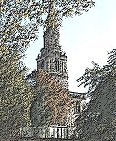
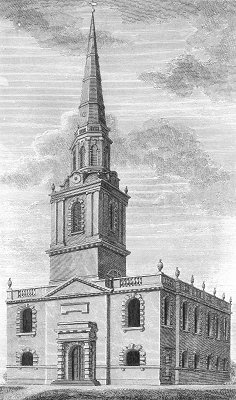 An early 19th century print of the church.
An early 19th century print of the church.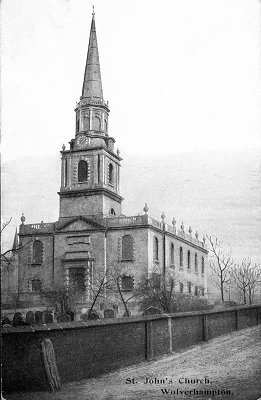
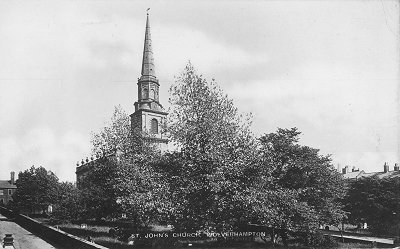 A later 20th century view, before the
ring road.
A later 20th century view, before the
ring road.